By Michael Barker
Doctrine and Covenants Section 19 (from Book of Commandments (BoC) 16 (cf. LDS D&C 19; Community of Christ (CoC) D&C 18))
Date: March 1830 (between 26 and 31)
Place: Manchester, Ontario County, New York
Historical Note: When the translation of the Book of Mormon was nearly completed, Joseph Smith , Oliver Cowdery, and Martin Harris solicited Egbert B. Grandin, manager and principal owner of the Wayne Sentinel, a newspaper printed in Palmyra, to print the manuscript. Grandin declined the request as did Thurlow Weed of Rochester when confronted with the proposition (although one of my other sources states that Grandin agreed only after he heard that Weed had accepted the job). Joseph and his associates finally prevailed on E.B. Grandin, and Martin Harris later signed a mortgage (25 August 1829) that bound Harris to pay Grandin $3, 000 within eighteen months for the printing of 5, 000 copies of the Book of Mormon or forfeit sufficient of his 240-acre Palmyra farm to pay the $3, 000. In March 1830, prior to the completion of the printing of the Book of Mormon, a group of townspeople near Palmyra voted not to purchase the book if it were published. Fearful that he might lose his farm if the book did not sell, Harris approached Joseph regarding the matter, and requested a revelation. Joseph Knight, Sr., remembering the occasion, made the following remarks (original spelling retained):
[Martin Harris] Came to us and after compliments he says, “The Books will not sell for no Body wants them.” Joseph says, “I think they will sell well.” Says he, “I want a Commandment [revelation].” “Why,” says Joseph, “fulfill what you have got.” “But,” says he, “I must have a Commandment.” Joseph put him off. But he insisted three or four times he must have a Commandment. [The following day] he got up and said he must have a Commandment to Joseph and went home. And along in the after part of the Day Joseph and Oliver Received a Commandment which is in the Book of Covenants [section 19].
The Book of Mormon was advertised as being available for purchase on 26 March 1830 in the Wayne Sentinel (Palmyra, NY).
Later Harris had to redeem the mortgage (which came due 5 February 1831) by selling 150 acres of his farm to Thomas Lakey on 1 April 1831 for $3, 000.
Publication Note: Section 19 was first published as chapter 16 in the Book of Commandments in 1833.
Revision: 1835 D&C 44 (cf. LDS D&C 19:13-15, 20-26, 32,35; RLDS D&C 18:2-3,5)
Commentary: Stress on Joseph Smith’s Revelations
BoC 16 is a commandment to M. Harris previous to the church’s organization. A comparison shows that the emphasis “I [God] command you by my name” is subordinated to Smith’s authority as revelator. The additional wording in the text would not have been what Harris had heard in 1830. The change emphasizes Harris’ need to obey the commandments he received through Smith.
Another textual addition qualifies the command to “show not these things, neither speak these things unto the world” with the words “until it is wisdom in me,” implying that Harris was to be silent on certain matters but that the 1835 committee was free of such proscription. That this is a correct understanding may be seen in a later revelation dated 3 November 1831 wherein it states clearly: “And for this cause these commandments were given; they were commanded to be kept from the world in the d[a]y that they were given, but now are to go forth unto all flesh[.]” (Evening and Morning Star 1 (May 1833)) This phrase “until it is wisdom in me” was probably added to the revelation for M. Harris because it would now be published to the world.
Original Inscription in Revelation Book 1: John Whitmer
Revisions in Revelation Book 1: Oliver Cowdery, William W. Phelps, Sidney Rigdon, Joseph Smith, John Whitmer, Unidentified.
The first publication reflecting most redactions in this section is the Book of Commandments (chapter 16).
Introduction to Church of Christ Years, Doctrine and Covenants 20-40: April 1830-May 1834
At Manchester, New York, early members received guidance as Joseph spoke words of encouragement. three church conferences were held in Fayette, NY. Instructions were given to relocate to the state of Ohio. Sidney Rigdon, a recent convert, became a scribe and friend of Joseph. The two worked periodically on a revision of the Bible, and revelations concerning their progress were received during this time. A communal law of consecration instructed members to consecrate their property and receive an inheritance from the church bishop. Kirtland, Ohio, was now church headquarters. A major emphasis was locating the New Jerusalem (Zion) in Jackson County, Missouri. Missionaries were called to preach to outsiders from the Bible, Book of Mormon, and Joseph’s revelations. For about a year, Joseph lived at John Johnson, Sr.’s residence in Hiram, Ohio. Problems with church members were solved by revelations from Joseph. Financial matters accelerated as the church borrowed money to purchase equipment and food items for its United Firm. Church members were forced to leave Jackson County. The concepts of Zion, temples, and priesthood were developed. The majority of Joseph’s pronouncements were given in Ohio during these early years.
Section 20 (One of the earliest manuscripts comes from Zebedee Coltrin Journal, LDS archives; First appeared in print in The Evening and the Morning Star, 1832; BoC 24 (cf. LDS D&C 20; CoC D&C 17))
Date: April 1830 (June (1-9), as per Book of Commandments)
Place: Fayette, Seneca County, New York, (as per Book of Commandments and now the new the new 2013 D&C!!).
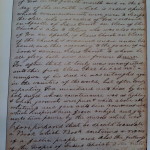
First page of the Articles and Covenants of the Church (D&C 20), copied by Orson Hyde into what he called the “Book of Commandments, Laws, and Covenants,” a manuscript revelation book he used on his mission with Samuel H. Smith.
Historical Note: Known as the “Articles and Covenants of the Church of Christ,” section 20 served as a constitution for the church; actually section 20 and 22 were initially both recognized as the “Articles and Covenants” of the Church (Evening and Morning Star [June 1832], p. 1). The revelation was at once a formal declaration of belief as well as a written modus operandi for administering the affairs of the divine organization. Authored by Joseph Smith and Oliver Cowdery (early draft of section 20, dated 1829 states Oliver was commanded to write section 20), section 20 soon became a standard against which proper conduct and procedure were measured. The writing of this revelation was begun sometime in 1829 but apparently not completed until after 6 April 1830. Section 20 was first presented to the Church membership for sustaining vote on 9 June 1830 at the first conference of the Church in Fayette, New York.
While Joseph and Oliver’s respective roles were clarified, the role Oliver’s Articles document played in the organization is unclear. Sometime after Oliver had completed the Articles, Joseph told him there was more. Joseph’s superseding revelation, now part of Doctrine and Covenants 20, seems to have been completed after the organizational meeting in April but before the Church’s first conference, held in June.10 At the June conference, this revealed document was accepted as a statement of polity for the new church. Its importance was highlighted by the fact that it was the first revelatory text published in the Church’s newspaper, and it was printed as the second section of the 1835 edition of the Doctrine and Covenants, after the “preface” dictated as a revelation in 1833.
The conference minutes of that date were copied into a record book called the Far West Record. The minutes state that the “Articles and Covenants [were] read by Joseph Smith jr. and received by unanimous voice of the whole congregation”. Though copied in 1832, the text in the Zebedee Coltrin Journal compares favorably with three other manuscripts.The “Articles and Covenants” were read aloud to the congregation almost as a routine requirement at the early Church conferences. But as Church leaders became more conversant with the revelation, an entire reading became less frequent. The continual reference to the revelation, evidenced throughout Church records during the lifetime of Joseph Smith, served to teach proper Church policy and procedure to leader and layman alike.
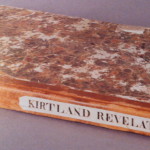
The Kirtland Revelation Book became the official manuscript book for Recording Joseph Smith’s revelations after the Book of Commandments and Revelations was taken to Missouri.
Section 20 was considered by the early missionaries a very important document. Many of them recorded the revelation in its entirety in their diaries to be quoted in their preaching. Additionally, Priesthood certificates stated that the bearer had been ordained “according to the Articles and Covenants of the Church.” When Lincoln Haskin desired to preach the gospel in 1832, a revelation stipulated that he should “be ordained and receive the articles and covenants which I have given unto you and some of the commandments that he may go forth and proclaim my gospel” (“Kirtland Revelation Book, ” p. 10).
Publication Note: Section 20 was first published in The Evening and the Morning Star (June 1832) and was include as chapter 24 in the Book of Commandments in 1833. Section 20, with some minor modifications, was published in the Painesville Telegraph, 19 April 1831. The editor of the Telegraph indicated that he had obtained a copy of the “Mormon Creed” from Martin Harris. Sections 22 and 27:1-4 were also published at the same time.
The published copy by The Painseville Telegraph has verses 71-72 reads as follows, “And the manner of baptism & the manner of administering the sacrament are to be done as it is written in the Book of Mormon.”
Revision: 1835 D&C 2 (cf. LDS D&C 20:6-19, 25-28, 32-34, 38-41, 45, 64-67, 72-73; RLDS D&C 17:2-6, 8-9, 15-17, 21)
Commentary: Offices in the Early Church
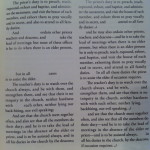
Comparison of verses from the Articles and Covenants of the Church (D&C 20) as they appeared in the June 1833 issue of the Evening and Morning Star (left) and Kirtland reprint (right), called simply Evening and Morning Star.
In the Articles and Covenants of the Church of Christ, is listed the following offices in the church: elder, priest, teacher, and deacon. The Articles and Covenants were read and received by a vote of the congregation at the first church conference on 9 June 1830 at Fayette, New York. At this time some men had been ordained to three of the four offices: elder, priest, and teacher. It was prior to 25 October 1831when the first known deacons were ordained. At the General Conference held on 3 June 1831, no deacons were listed as functioning in the church. Some scholars wonder if the office of deacon was in the original Articles and Covenants. What is known is that the office of deacon would have been in the June 1830 text by 19 April 1831 when a copy of the document was published in the Painesville Telegraph. All extant manuscripts mention the teacher’s duties “to be assisted alway[sic] & in all his duties in the Church by the deacons” (Zebedee Coltrin Journal). The words “or deacon” were added once in 1835 D&C 2:15. As the church grew, additional offices or callings became part of the ecclesiastical structure. By 1835 it was felt necessary to add these offices to the Articles and Covenants, though such a step created an anachronism.
There are at least four early manuscripts which do not contain the additional offices in the Church. One document was published twice in the The Evening and the Morning Star and in BoC 24.
In three subsequent revelations, mention is made to church members to remember and observe the church articles. This would refer to the early text that was voted upon in June 1830, not to the 1835 text.
Three offices not mentioned in this addition are those of the patriarch, twelve apostles, and seventy. The office of twelve apostles was not established until 14 February 1835. By the omission, one can determine the earliest date when the addition was written. It would have been after the Kirtland High Council was established and before any ordinations to the last two offices. The first published source of the revised text was in the reprint of the Evening and Morning Star (Kirtland, Ohio) published in January 1835, a month before the Council of Twelve Apostles was established.
Offices mentioned in the revised text were developed as follows: bishop, 4 February 1831; high priests (ordained to the high priesthood), 3 June 1831; president of the high priesthood, 25 January 1832; traveling bishops, 22-23 September 1832; high council, 17 February 1834; and high counselors, 17 February 1834.
Original Inscription in Revelation Book 1: John Whitmer
Revisions in Revelation Book 1: Oliver Cowdery, William W. Phelps, Sidney Rigdon, Joseph Smith, John Whitmer, Unidentified.
The first publication reflecting most redactions in this section is the June 1832 issue of The Evening and the Morning Star. Throughout Revelation Book 1, much of the ink used by Oliver Cowdery and John Whitmer to make changes appears to match, possibly indicating that they made changes at the same time.
Section 21(BoC 22 (cf. LDS D&C 21; CoC D&C 19))
Date: 6 April 1830
Place: Conflicting information: Manchester, New York -as per our modern D&C; Fayette, New York – as per Book of Commandments.
Historical Note: The Church was officially organized on Tuesday, 6 April 1830, at Fayette, New York (although some records indicate Manchester). The six charter members were Joseph Smith, Oliver Cowdery, Hyrum Smith, David Whitmer, Samuel H. Smith, and Peter Whitmer, Jr. The name of the new church was “The Church of Christ.” This revelation also gives instructions to proceed with ordaining Joseph Smith as a prophet and seer over the Church.
The state law under which the “Church of Christ” was incorporated was entitled “An Act to provide for the Incorporation of Religious Societies,” passed 5 April 1813. The law, which stipulated that a certificate of incorporation be recorded with the county clerk, designated that “any number of discreet persons of their church…not less than three, nor exceeding nine” could “transact all affairs relative to the temporalities thereof” (the certification of incorporation has not been found).
On 3 May 1834, the name of the Church was changed to “The Church of the Latter-day Saints”, and on 26 April 1838, eight years after the Church’s organization, the final designation of the Church was given by revelation: “The Church of Jesus Christ of Latter-day Saints.” Concerning the organization of the Church, Joseph Knight, Sr., wrote (original spelling retained):
“Now in the Spring of 1830 I went with my Team and took Joseph out to Manchester to his father. When we was on our way he told me that there must be a Church formed But did not tell when…I stayed a few Days wating some Books to Be Bound. Joseph said there must Be a Church Biltup …On the sixth Day of April 1830 he Begun the Church with six members and received the following Revelation Book of Covenants Page 177 [section 21, 22]. They all kneeled down and prayed and Joseph gave them instructions how to Bild up the Church and exorted them to Be faithful in all things for this is the work of God.”
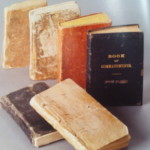
Six surviving copies of the Book of Commandments, assembled from pages salvaged after a mob destroyed the Church printing office in 1833. Note the varied bindings.
Publication Note: Section 21 was first published as chapter 22 in the Book of Commandments in 1833.
Original Inscription in Revelation Book 1: John Whitmer
Revisions in Revelation Book 1: Oliver Cowdery, William W. Phelps, Sidney Rigdon, Joseph Smith, John Whitmer, Unidentified.
The first publication reflecting most redactions in this section is the Book of Commandments (chapter 22).
Section 22 (one of the earliest manuscripts comes from the William E. McLellin Collection, LDS archives; First appeared in print in The Evening and the Morning Star, 1832; BoC 23 (cf. LDS D&C 22; CoC D&C 20)
Date: April 1830 (perhaps on the 16th of April; the new 2013 D&C dates this revelation on the 16th of April. )
Place: Conflicting information: Our modern D&C states this was received in Manchester, Ontario County, New York. The 1833 BoC states the revelation was received in Fayette, New York.
Historical Note: Initially considered part of the “Articles and Covenants” of the Church, section 22 was given to Joseph Smith in answer to the question of whether believers who had received baptism in other churches, should again be baptized. In 1873 Orson Pratt recalled the historical setting of this revelation:
“In the early days of his Church there were certain persons, belonging to the Baptist denomination, very moral and no doubt as good people as you could find anywhere, who came, saying they believed in the Book of Mormon, and that they had been baptized into the Baptist Church. The Prophet Joseph had not, at that time, particularly inquired in relation to this matter, but he did inquire, and received a revelation from the Lord [section 22]…These Baptists had to be re-baptized: there was no other way to get into this Church.”
The Fayette branch of the Church was established on 11 April 1830. Baptisms were also performed at Fayette on 18 April 1830. The BoC contains the following in the introduction to this document:
“Given in Fayette, New York, April, 1830, in consequence of some desiring to unite with the church without re-baptisms, who had previously been baptized.”
Sixteenth-century reformers were pejoratively called Anabaptists (re-baptizers) when they followed the biblical practice of immersing accountable believers, including people already baptized as infants. The American Baptist leader Francis Wayland defended this practice:
“We consider ourselves not to baptize again…but to baptize those who have never yet submitted to this ordinance.”
Section 22 follows this logic and takes it a step further.
Publication Note: Section 22 was first published as chapter 23 in the Book of Commandments in 1833.
Original Inscription in Revelation Book 1: John Whitmer
Revisions in Revelation Book 1: Oliver Cowdery, William W. Phelps, Sidney Rigdon, Joseph Smith, John Whitmer, Unidentified.
The first publication reflecting most redactions in this section is the June 1832 issue of The Evening and the Morning Star. Throughout Revelation Book 1, much of the ink used by Oliver Cowdery and John Whitmer to make changes appears to match, possibly indicating that they mad changes at the same time.
Section 23
From BoC 17 (cf. LDS D&C 23:1-2; CoC D&C 21:1) for Oliver Cowdery
From BoC 18 (cf. LDS D&C 23:3; CoC D&C 21:2) for Hyrum Smith
From BoC 19 (cf. LDS D&C 23:4; CoC D&C 21:3) for Samuel H. Smith
From BoC 20 (cf. LDS D&C 23:5; CoC D&C 21:4) for Joseph Smith, Sr.
From BoC 21 (cf. LDS D&C 23:6-7; CoC D&C 21:5) for Joseph Knight, Sr. #
Date: April 1830 (6 April, according to the Book of Commandments).
Place: Manchester, Ontario County, New York.
Historical Note: In the Book of Commandments section 23 was printed as five separate revelations (i.e., chapters 17, 18, 19, 20 and 21).
Five of the 6 April 1830 revelations “given in Manchester, New York” were combined into one revelation given to five individuals. The 1835 D&C retained the same basic wording but dropped the location where the Church of Christ was organized from the headings. Six revelations (BoC17-22) were originally dated 6 April.
Only one of these retained the same date when published in the 1835 D&C. This was BoC 22 (1835 D&C 46) which mentions that a record should be kept and that Joseph should be ordained by Oliver Cowdery. All indications confirm that Joseph and Oliver were present at the Smith residence at the time of the historic meeting. The following time-line below will help clarify the events for March to June 1830:
Palmyra, New York
26 March – The Wayne Sentinel advertises the Book of Mormon for sale.
Manchester, New York
[26-31] March – Joseph Smith arrives in Manchester with Joseph Knight, Sr.; a commandment is given to Harris (BoC 16; LDS D&C 19; CoC D&C 18).
6 April – The Church of Christ is organized; six revelations are received (BoC 17-22; LDS D&C 21, 23; CoC D&C 19, 21). Oliver Cowdery is ordained an elder, Joseph Smith is ordained an elder, prophet, and seer by Cowdery. Joseph Smith, Sr., Lucy Mack Smith, Martin Harris, and Sarah Rockwell are baptized in Crooked Brook.
Fayette, New York
11-16 April – A Fayette, New York, branch of the church is established. Cowdery delivers the first public discourse of the church and performs baptisms. A revelation is received regarding individuals who have been baptized in other Christian churches (BoC 23; LDS D&C 22; CoC D&C 20).
18 April – More baptisms are performed by Cowdery
9 June – The first conference of the church is held; articles and covenants are presented (BoC 24; LDS D&C 20; CoC D&C 17). Baptisms are performed. Joseph Sr. and Hyrum Smith are ordained priests.
There are several possible explanations for the 1835 change of venue (from Manchester to Fayette). It is possible that memories of these momentous events became conflated over time. It is also possible that image-consciousness played a role. It may have seemed impressive to advertise the church’s founding at a distant location, away from the Smiths’ humble log cabin and critics of the family. More likely was a motivation to render ambiguous the church’s legal history at a time when creditors were demanding satisfaction – a rationale which might also explain why the church’s name was changed in mid-1834.
Publication Note: Section 23 was first published in the Book of Commandments in 1833.
Biopgraphical Note: Samuel Harrison Smith.
Born 13 March 1808 at Tunbridge, Orange County, Vermont. Baptized 25 May 1829. Traditionally recognized as first missionary of the Church. Married Mary Bailey 13 August 1834. Had four Children: Susanna Bailey, Mary Bailey, Samuel Harrison Bailey, and Lucy Bailey. Participated in Battle of Crooked River October 1838. Called as bishop of Nauvoo Ward. Married Levira Annette Clark, Louisa Clark, and Lucy Jane Clark. Initiated into Masonry 9 April 1942. Moved to Plymouth, Illinois, in fall of 1842. Received endowment 17 December 1843. Died 30 July 1844 at Nauvoo, Hancock County, Illinois.
Original Inscription in Revelation Book 1: John Whitmer
Revisions in Revelation Book 1: Oliver Cowdery, William W. Phelps, Sidney Rigdon, Joseph Smith, John Whitmer, Unidentified.
The first publication reflecting most redactions in this section is the Book of Commandments (chapter 19).
#Joseph Knight, Sr., was not baptized at this time. He had not read the Book of Mormon and wanted to examine it more.
Bibliography
Lyndon W. Cook, The Revelations of the Prophet Joseph Smith: A Historical and Biographical Commentary of the Doctrine and Covenants, Deseret Book, 1985
H. Michael Marquardt, The Joseph Smith Revelations: Text and Commentary, Signature Books, 1999
Richard P. Howard, Restoration Scriptures: A Study of Their Textual Development, Second Edition, Herald Publishing House, 1995
Steven C. Harper, Making Sense of the Doctrine and Covenants: A Guided Tour through Modern Revelations, Deseret Book, 2008
Richard Lyman Bushman, Joseph Smith, Rough Stone Rolling: A Cultural Biography of Mormonism’s Founder, Knopf, Borzoi Books, 2005
Richard E. Turley Jr., William W. Slaughter, How We Got the Doctrine and Covenants, Deseret Book, 2012
Joseph Smith, Junior – Compiler, The Parallel Doctrine and Covenants, The 1832-1833, 133, and 1835, Editions of Joseph Smith’s Revelations, The Smith-Pettit Foundation, 2009
Robin Scott Jensen, Robert J. Woodford, Steven C. Harper- Volume Editors, The Joseph Smith Papers: Revelations and Translations, Manuscript Revelation Books, The Church Historian’s Press, 2009


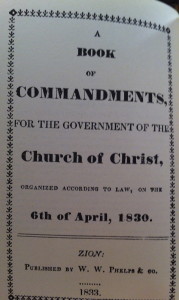
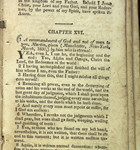
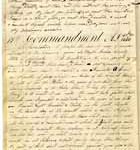




Great info, Michael. One minor correction that I thought I’d bring your attention to. According to Robert Woodford,
Robert J. Woodford, “Discoveries from the Joseph Smith Papers Project: The Early Manuscripts,” in Andrew H. Hedges, J. Spencer Fluhman, & Alonzo L. Gaskill, The Doctrine and Covenants: Revelations in Context (Provo: BYU Religious Studies Center, 2008), ch. 2.